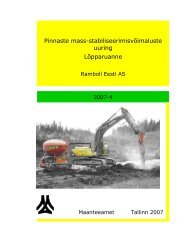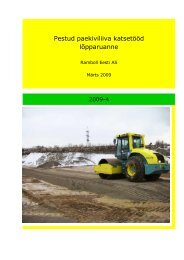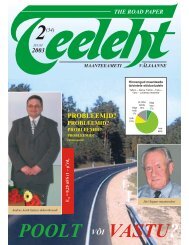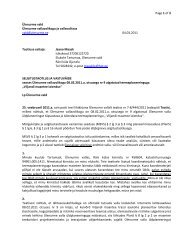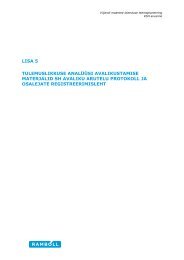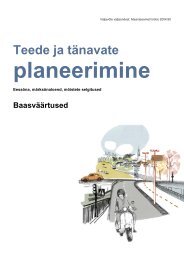tiitelleht maanteede remondi geotekstiilide ja ... - Maanteeamet
tiitelleht maanteede remondi geotekstiilide ja ... - Maanteeamet
tiitelleht maanteede remondi geotekstiilide ja ... - Maanteeamet
You also want an ePaper? Increase the reach of your titles
YUMPU automatically turns print PDFs into web optimized ePapers that Google loves.
LÕPPARUANNE – MAANTEEDE REMONDIL GEOTEKSTIILIDE JA ARMEERVÕRKUDE KASUTAMINE<br />
18. ABSTRACT<br />
USE OF GEOTEXTILES AND -GRIDS ON ESTONIAN STATE ROADS 2002-2006<br />
Geosynthetics is concept for a certain group of materials. These are synthetical materials used<br />
in land and hydraulic constructions. There is a wide variety of geosynthetics in use that are<br />
meant for performing different functions in different building-constructions and their parts,<br />
including road building. In road building, they are used widely all over the world. In<br />
developed countries there are almost no roads without geosynthetic components. In Estonia<br />
first steps are still taken in the field of geosynthetical road building, however almost 47 km of<br />
reinforcement geosynthetics has already been installed in the state roads, including 12 km of<br />
steel grids. This research analyses the use of geosynthetics in Estonian roads that have been<br />
built from 2002-2006.<br />
In 10.01.2006 Technical Center of Estonian Roads Ltd. and Estonian Road Administration<br />
signed a contract for researching the behavior of different geosynthetics and steel grids in<br />
exploitation and therefore making suggestions for successive use of geosynthetics. To make<br />
sure whether it is useful to use geosynthetics, defects were accessioned all over the coverage<br />
of geosynthetics. Roughness, dynamical pressure and transversal roughness were measured on<br />
almost all of the road parts to see what effects geosynthetics had on roads. From those results<br />
conclusions were made. Geosynthetics that are deployed into road-constructions differ in their<br />
function. There are two types of geosynthetics: ones that are placed in the soil and ones that<br />
are mounted into asphalt-constructions. In either case different standards are followed.<br />
The usage of geosynthetics in road building is overseen by the Estonian standard EVS-EN<br />
13249:2001 with a supplement A1:2005 that is based on the European standard EN<br />
13249:2001. European standard EN 13249:2001 states that the numbers of different<br />
characteristics have to be assigned to a geosynthetic with a certain function. In case of<br />
different functions the list of characteristics differs. All the materials in use have to respond to<br />
the required standard. There is no qualification system for geosynthetics in Estonia, but there<br />
are different qualification systems for geosynthetics elaborated by specialists from all over the<br />
world. One of the possible version is NorGeoSpec from the Nordic Countries and the other<br />
one is GRK thought up by the Germans.<br />
When using NorGeoSpec, you can choose an appropriate geosynthetics for a certain situation<br />
for separating and filtrating different layers of soil. NorGeoSpec takes into account the<br />
qualities of subsoil and infilling, the building conditions and the quality requirements meant<br />
for the road.<br />
GRK divides geotextiles into five different classes by their resistance to mechanical<br />
deformation; therefore GRK is based on the qualities of geotextiles.<br />
The primal Contract goal was to compile new guide for using geosynthetics, but it was<br />
changed, because it had already been done and Estonian Road Administration ratified it. So<br />
the new Contract goal was to supplement the existing guide.<br />
84




